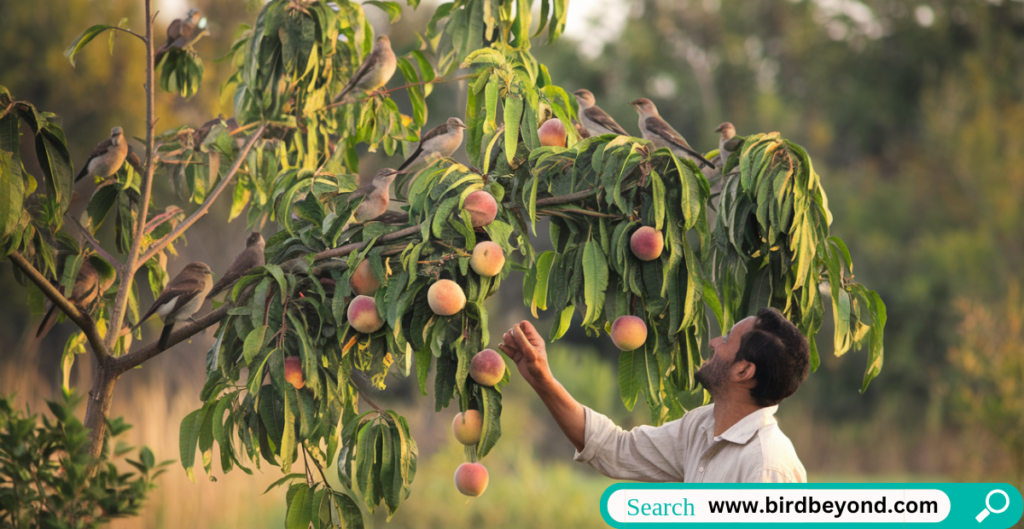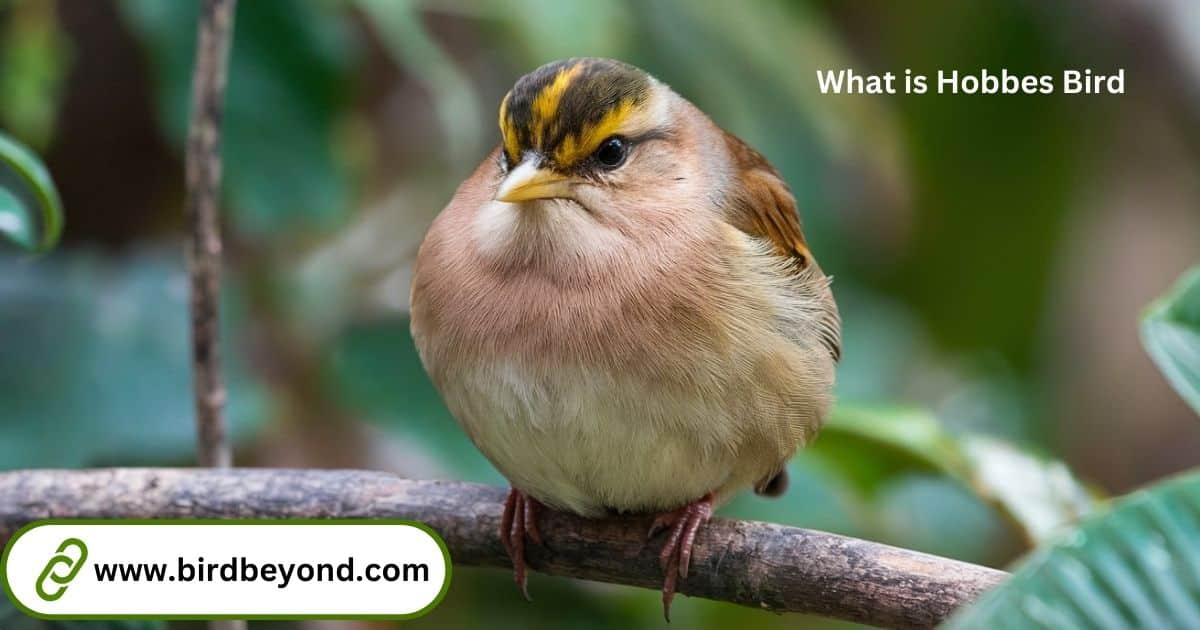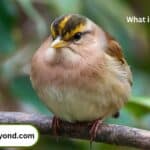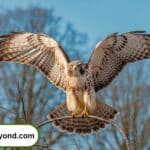Have you ever wondered, “Can birds eat peaches?” As you bite into a juicy peach on a warm summer day, you might notice a curious feathered friend eyeing your snack. Birds are naturally drawn to colorful fruits, and peaches are no exception. But before you start sharing your fruit bowl with your backyard visitors, let’s dive into the juicy details of feeding peaches to birds.
The Nutritional Value of Peaches for Birds

Peaches aren’t just a tasty treat for humans; they can also provide valuable nutrients for our avian friends. But can birds eat peaches safely? The answer is a resounding yes, with some important considerations.
Key Vitamins and Minerals
Peaches are packed with essential nutrients that can benefit birds:
- Vitamin A: Supports eye health and immune function
- Vitamin C: Boosts immune system and aids in iron absorption
- Potassium: Helps maintain proper nerve and muscle function
- Fiber: Aids in digestion and promotes gut health
Sugar Content and Its Effects on Birds
While peaches are nutritious, they’re also high in natural sugars. Birds can digest these sugars, but moderation is key. Too much sugar can lead to:
- Obesity
- Dental issues
- Nutritional imbalances
It’s crucial to offer peaches as part of a varied diet, not as the main course.
Comparison to Other Fruits in a Bird’s Diet
Here’s how peaches stack up against other fruits commonly fed to birds:
| Fruit | Vitamin C (mg/100g) | Sugar Content (g/100g) | Fiber (g/100g) |
|---|---|---|---|
| Peaches | 6.6 | 8.4 | 1.5 |
| Apples | 4.6 | 10.4 | 2.4 |
| Berries | 9.7 | 5.4 | 2.0 |
| Grapes | 3.2 | 16.2 | 0.9 |
As you can see, peaches offer a good balance of nutrients and aren’t excessively high in sugar compared to some other fruits.
Birds That Naturally Eat Peaches

In the wild, many bird species feast on fruits like peaches. Understanding which birds are attracted to peaches can help you cater to your local feathered population.
Wild Fruit-Eating Species
Several wild birds have a natural affinity for fruits, including peaches:
- Orioles
- Tanagers
- Mockingbirds
- Grosbeaks
- Blue Jays
- Robins
These birds have adaptations that make them particularly suited to eating fruits. For instance, orioles have sharp, pointed beaks perfect for piercing soft fruits.
Backyard Birds Attracted to Peaches

If you’re wondering about birds eating peaches in your backyard, you might spot these common visitors:
- American Robins
- Northern Cardinals
- Cedar Waxwings
- Gray Catbirds
- House Finches
These birds are often drawn to fruit-bearing trees and bushes, making them likely candidates to enjoy peaches at your bird feeder.
Regional Variations in Peach-Eating Bird Populations
The types of birds attracted to peaches can vary depending on your location. For example:
- Southeastern United States: You might see more Summer Tanagers and Brown Thrashers enjoying peaches.
- Western United States: Western Tanagers and Bullock’s Orioles are more likely to visit peach feeders.
- Northern regions: During migration seasons, various fruit-eating birds might stop by for a peachy snack.
How to Safely Offer Peaches to Birds
Now that we know birds can eat peaches, let’s explore the best ways to serve this fruity treat to our feathered friends.
Proper Preparation Techniques
To ensure the peaches are safe and accessible for birds:
- Washing and cleaning: Thoroughly wash peaches to remove any pesticides or contaminants.
- Cutting and serving sizes: Cut peaches into small, bite-sized pieces to prevent choking.
“Always remove the pit when feeding peaches to birds. The pit contains compounds that can be harmful if ingested.” – Dr. Emma Finch, Avian Nutritionist
Best Placement Methods in Your Yard
When it comes to feeding birds peaches, placement is key:
- Use a platform feeder for larger birds like jays and cardinals.
- Hang peach slices from branches for orioles and tanagers.
- Place peach pieces in a shallow dish for ground-feeding birds like robins.
Seasonal Considerations for Feeding Peaches

While birds can enjoy peaches year-round, consider these seasonal tips:
- Spring and Summer: Offer fresh, ripe peaches when they’re in season.
- Fall: Provide dried peaches as a high-energy snack for migrating birds.
- Winter: Frozen peaches can be a welcome treat for winter residents.
Potential Risks and Precautions
While peaches can be a healthy treat for birds, there are some risks to be aware of.
Pesticide Concerns with Store-Bought Peaches
Store-bought peaches often contain pesticide residues. To minimize risks:
- Choose organic peaches when possible.
- Wash all peaches thoroughly before offering them to birds.
- Consider growing your own pesticide-free peaches.
Avoiding Spoilage and Mold
Peaches can spoil quickly, especially in warm weather. To prevent mold growth:
- Only put out small amounts of peach at a time.
- Remove uneaten peaches after a few hours.
- Clean bird feeders regularly to prevent bacterial growth.
Choking Hazards and Pit Dangers
The pit of a peach poses serious risks to birds:
- Always remove the pit before offering peaches to birds.
- Cut peaches into appropriately sized pieces for different bird species.
- Monitor feeders to ensure birds aren’t struggling with large pieces.
Alternative Fruits for Bird Feeding
While peaches are a great option, variety is key in a bird’s diet. Here are some other fruits you can offer:
- Berries (strawberries, blueberries, raspberries)
- Apples (remove seeds)
- Grapes (cut in half for smaller birds)
- Cherries (remove pits)
- Melons
Each fruit offers different nutritional benefits, so mix it up to provide a well-rounded diet.
DIY Peach Bird Feeder Ideas
Get creative with your peach offerings! Here are some simple DIY feeder ideas:
- Peach Skewer: Thread peach chunks onto a wooden skewer and hang from a branch.
- Peach Cup: Cut a peach in half, remove the pit, and secure it to a platform feeder.
- Fruit Garland: String various fruits, including peach pieces, on a natural twine.
Remember to clean these feeders regularly to prevent mold and bacteria growth.
Observing and Enjoying Peach-Eating Birds
Offering peaches can provide excellent bird-watching opportunities. Here are some tips:
- Best times for observation: Early morning and late afternoon are peak feeding times.
- Photography tips: Use a zoom lens to capture birds without disturbing them.
- Citizen science: Participate in projects like FeederWatch to contribute your observations.
Environmental Impact of Feeding Peaches to Birds

While feeding birds can be enjoyable, it’s important to consider the broader ecological impact.
Effects on Local Ecosystems
Supplemental feeding can:
- Alter bird populations and migration patterns
- Potentially spread diseases if feeders aren’t kept clean
- Attract unwanted visitors like rodents
Balancing Supplemental Feeding with Natural Foraging
To promote a healthy balance:
- Offer peaches and other fruits in moderation
- Maintain native fruit-bearing plants in your yard
- Vary the types of food you offer to encourage natural foraging behaviors
Conclusion: The Peachy Truth About Birds and Fruit
So, can birds eat peaches? Absolutely! When offered safely and in moderation, peaches can be a nutritious and enjoyable treat for many bird species. By following the guidelines we’ve discussed, you can provide a peachy feast that’s both safe and beneficial for your feathered visitors.
Remember, while birds eating peaches can be a delightful sight in your backyard, it’s just one part of a varied and balanced diet. Combine your peach offerings with other bird-safe fruits, seeds, and natural food sources to create a thriving bird haven.
Whether you’re setting up a bird feeder peaches station or simply sharing a slice from your own snack, you’re now equipped to safely and responsibly offer this sweet treat to your avian friends. Happy bird feeding!
-
Do Birds Eat Squirrels?
Introduction: The Curious Case of Squirrels and Cat Food Do Birds Eat Squirrels encounters in our backyards often spark fascinating questions about animal behavior. One common query that homeowners and pet enthusiasts frequently ask is: do squirrels eat cat food? The short answer is yes, squirrels can and will eat cat food if given the…
-
What is Hobbes Bird? Unraveling a Philosophical Metaphor
This comprehensive exploration unpacks the origins, characteristics, and enduring relevance of the Hobbes Bird in today’s world. By the end, you’ll not only understand what the Hobbes Bird symbolizes but also why its lessons remain vital. The Hobbes Bird is not a creature you’ll find in the wild. Instead, it exists in the realm of…
-
7 Types of Hawks in Michigan: Ultimate ID Guide with Pictures
Hawks represent extraordinary predators that have sculpted intricate ecological relationships across Michigan’s diverse landscapes. Types of Hawks That Live in Michigan showcase remarkable adaptability, survival strategies, and unique characteristics that make them essential components of the state’s complex ecosystems. Michigan’s geographical diversity creates perfect habitats for multiple hawk species, each evolving specialized traits to thrive…

William Henry is a distinguished blogger with a flair for avian storytelling. With a wealth of experience, he delivers captivating insights and expert knowledge to Bird Beyond. William’s passion for birds and his engaging writing style make him a standout voice in the birdwatching community, offering readers both valuable information and delightful narratives.










